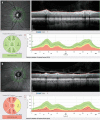The Diagnosis and Treatment of Glaucoma
- PMID: 32343668
- PMCID: PMC7196841
- DOI: 10.3238/arztebl.2020.0225
The Diagnosis and Treatment of Glaucoma
Abstract
Background: Glaucoma is a group of chronically progressive disorders of the optic nerve. In this article, we present the epidemiology of and risk factors for glaucoma, as well as the diagnostic work-up and treatment options.
Methods: This review is based on pertinent publications retrieved by a selective search in Medline and the Cochrane Library, supplemented by further articles chosen by the authors.
Results: In Europe, the prevalence of glaucoma is 2.93% among persons aged 40 to 80 years. The prevalence rises with age, reaching 10% in persons over 90 years old. The available diagnostic methods include ophthalmoscopy, tonometry, perimetry, and imaging techniques. The treatment of glaucoma is focused on lowering the intraocular pressure with topical drugs, laser therapy, and glaucoma surgery. In patients with manifest glaucoma, lowering the intraocular pressure prevents the progression of visual field defects, with a number needed to treat of 7.
Conclusion: The diagnostic evaluation of glaucoma rests on multiple pillars, all of which must be considered for establishing the diagnosis and defining the desired target pressure: these are, among others, the intraocular pressure and ocular function and morphology. Individually tailored pressure-lowering treatment should be evaluated in regularly scheduled follow-up visits for assessment of function and morphology and adjusted as necessary to minimize the risk of progression.
Figures





References
Publication types
MeSH terms
LinkOut - more resources
Full Text Sources
Medical

